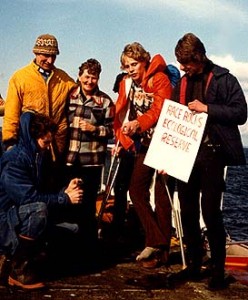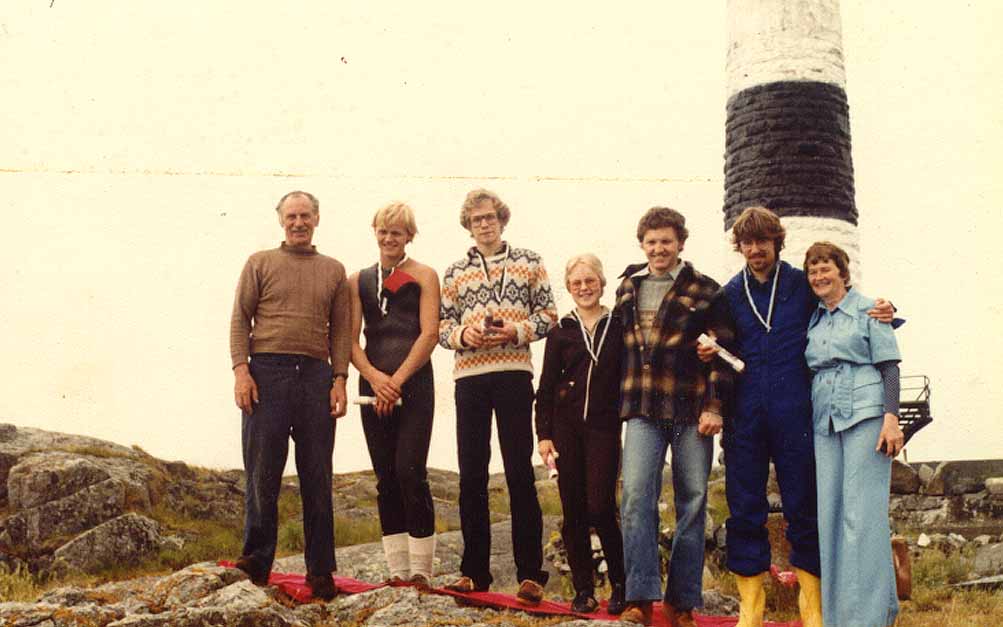Dive boat in reserve.
Private boat speeding in the reserve.
Private vessel with two divers Sunday.
Three Eco tour vessels respectively viewed animals in main channel.

Dive boat in reserve.
Private boat speeding in the reserve.
Private vessel with two divers Sunday.
Three Eco tour vessels respectively viewed animals in main channel.
On October 22nd we were invited to the 100th year birthday party for Trevor Anderson, the light keeper at Race Rocks when it became an Ecological Reserve. Trev and Flo Anderson had arrived at Race Rocks with their family in 1966, and served at the station until they had built a boat and left to sail across the Pacific Ocean in 1982. They had been married for 70 years in 2014 and Flo Anderson passed away in 1977.
I first met the Andersons in 1976 and the students from Lester Pearson College in the Diving Marine Science and Biology programs started coming out to the Islands for field trips and SCUBA diving, with some even spending their project weeks studying and working at the islands. Students in the Diving and Sea Rescue Services at Pearson College developed a close relationship with these neighbours 5 km out at sea. After many of our dive sessions whenour students were invited into their home for tea and cookies, the students would talk excitedly about the incredible sea-life they were seeing at under water. In the late 1970s we started to visit Race Rocks more frequently and the Andersons invited students to stay on project weeks.
Trev and Flo were the first to plant the seed of an idea urging us to see if we could get the government to do some formal recognition and protection of the Race Rocks Area. What they could see at low tide alone was impressive enough, but if the underwater life also could be protected, that would be ideal. In the years 1997 and 1998 we recorded the unique life underwater by logging dives from over 80 locations throughout the Race Rocks archipelago, and by February of 1979 a highly successful workshop took place, with officials invited from the Provincial Museum, the University of Victoria, and the Ministry of Parks who were all enthusiastic and supportive of our proposal.
Throughout that year we worked at the task of formalizing our proposal, presenting it to cabinet and lobbying to get action. Two students in diving and marine science, Johan Ashuvud from Sweden and Jens Jensen from Denmark were especially relentless in their pursuit of our goal. The proposal had to clear 11 agencies in the government bureaucracy and the cabinet before the Reserve could be proclaimed. These two students invited the Director of the Ecological reserves Branch Bristol Foster, and the Deputy Minister of Parks Tom Lee out to dive and then kept following it up with phone calls, even after hours! Their persistence finally paid off when after a year, the shortest time any reserve proposal has ever taken, the Minister of Parks was able to request Prince Charles on his visit to the college as international board president (April 1980) to make the formal announcement proclaiming Race Rocks the 97th Provincial Ecological Reserve.
 The day we received the information that the reserve was proclaimed by the Ecological Reserves Branch of the Ministry of Lands Parks and Housing, The group of students who had worked so hard on the proposal went out to Race Rocks to give the news to Trev and Flo and present them with a very unofficial looking sign.
The day we received the information that the reserve was proclaimed by the Ecological Reserves Branch of the Ministry of Lands Parks and Housing, The group of students who had worked so hard on the proposal went out to Race Rocks to give the news to Trev and Flo and present them with a very unofficial looking sign.
The next week Trev and Flo asked the group of students who had worked so hard to establish the Ecological Reserve to come out to the island one afternoon where they presented the students with medals and “The Order of Race Rocks” as recognition and appreciation for their work in creating the Ecological reserve.

Trev, Hans, Johan, Iina, Garry, Jens and Flo
FER Board member Garry Fletcher taught at Lester Pearson College from 1996 to 2004 and has been the ecological reserve warden for Race Rocks since 1980.
Weather Today:
Visitors: Few boats through the reserve today as the seas have been a bit rough. A few eco-tourism boats in late afternoon watching a humpback whale just outside of the reserve.
Ecological:
Census:
Veterinarian Martin Haulena from the Vancouver Aquariums Marine Mammal Rescue Centre attends to the injured sea lion.
photo: MARA RADAWETZ
A sea lion with a plastic packing band cinched around its neck was rescued near Race Rocks on Sunday, thanks to the combined efforts of rescue teams from Victoria and Vancouver.
The struggling sea lion was first spotted by Mara Radawetz, who lives in the decommissioned lightkeepers’ residence at Race Rocks, just off the southern tip of Vancouver Island. Radawetz, who monitors the Race Rocks Ecological Reserve with partner Kai Westby on behalf Metchosin’s Pearson College, saw the sea lion several times during the week in nearby Juan de Fuca Strait, and said the marine mammal was clearly in distress.
“He was scratching constantly at his wounds, which were cutting into his skin,” Radawetz said.
She contacted Fisheries and Oceans Canada and the Vancouver Aquarium’s Marine Mammal Rescue Centre, Canada’s only dedicated marine mammal rescue facility and one of the largest rescue facilities in the world, to help free the sea lion from the plastic packing band wrapped around its neck.
Two large Zodiac boats carrying the rescue team and several veterinarians arrived Sunday morning, and quickly found the sea lion, Westby said. After being given a tranquilizer injection by veterinarian Martin Haulena from the Marine Mammal Rescue Centre, the sea lion was brought onto the shores of Race Rocks and treated.
The plastic band was removed and tracking tags were attached to the animal’s front flippers. A blood sample was also taken, to assist with future studies. After being given a drug to reverse the effects of the tranquilizer, the sea lion was back swimming within minutes, Westby said. “It was great to see them help out an animal that was in such great pain.”
Suffering caused by man-made material such as plastic is an increasingly common problem among sea lions, Westby said. As permanent residents on Race Rocks, he and Radawetz see their share of injuries to sea lions.
“It can be pretty sad to see. They live for 20 years or 30 years, and as the animal grows, the band cuts through its skin. It becomes a really painful-looking wound.”
mdevlin@timescolonist.com
I am posting these videos from Youtube here with a precautionary warning; The behaviours demonstrated by some the divers could be very dangerous. Trying to touch sealions and putting a hand in their mouth and even staying in the water when they get agitated is very unwise. When a sealion starts snapping his teeth at an intruder it is best to move on. A sealion bite can be very toxic, and they have been known to ram into divers , especially if a diver enters a zone where they have been actively hunting for fish. Department of Fisheries regulations warn against any interaction with marine mammals
Today’s Weather Conditions:
Marine Traffic/Island Visitors:
Ecological Observations:
Today’s Weather:
Marine Traffic/Visitors:
Ecological Observations:
Census:
Throughout the week we also observed pigeon guillemots, eagles, and a pair of swallows. The sea lion who was here alone over the past weeks seems to have moved along.
Today’s Weather Conditions:
Visitors/Marine Traffic:
Ecological Observations:
Census:
Today’s Weather Conditions:
Visitors/Marine Traffic:
Ecological Observations:
Weather:
Visitors:
Ecological:
Census: